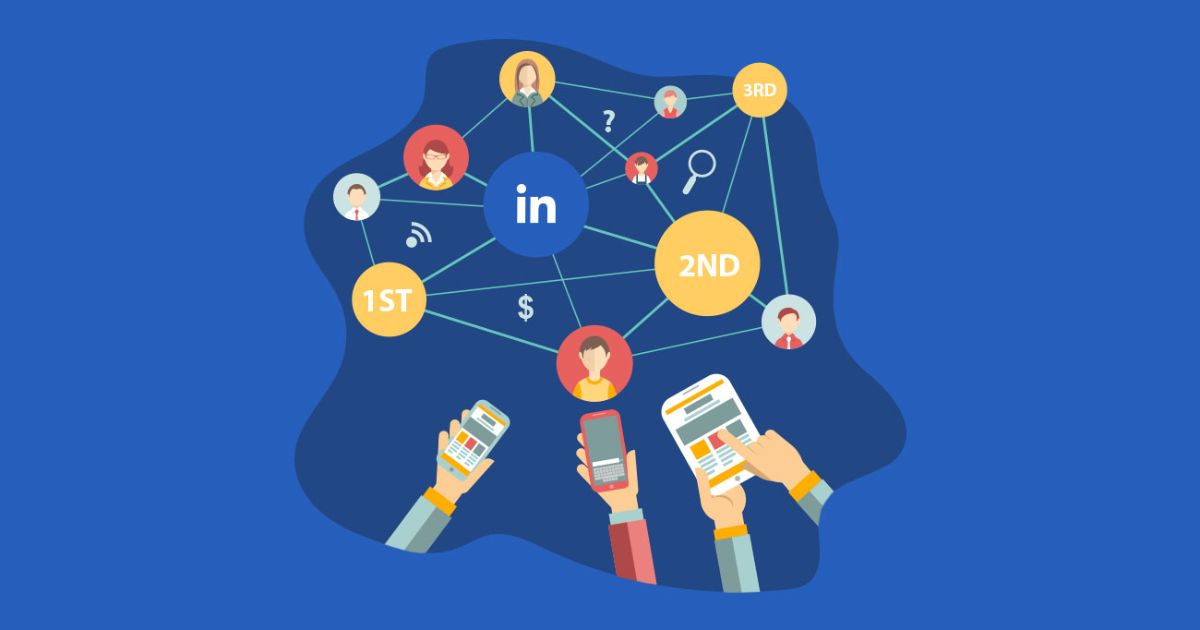LinkedIn uses the concept of 1st, 2nd, and 3rd-degree connections. These different levels indicate how closely you are connected to someone on the platform.
1st-degree connections are people you are directly connected with. You can see their full profile and message them.
2nd-degree connections are people connected to your 1st-degree connections. You share a mutual connection but are not directly linked.
3rd-degree connections are people connected to your 2nd-degree connections. They are even further removed from your network.
The closer the connection degree, the more access you have to someone’s information and ability to interact with them directly.
More Post
Networking Quotes for Pros
Understanding LinkedIn Connection Degrees

LinkedIn categorizes your connections into three levels: 1st, 2nd, and 3rd-degree.
1st-degree are people you are directly connected with.
2nd-degree are friends of your 1st-degree connections.
3rd-degree are friends of your 2nd-degree connections.
The higher the degree, the more distant the connection is from your main network. Understanding these levels helps you navigate your LinkedIn relationships more effectively.
1st-degree connections
- These are people you are directly connected to on LinkedIn.
- You can see their full profile and send them messages.
2nd-degree connections
- These are friends of your 1st-degree connections.
- You have a mutual connection with them, but you are not directly linked.
- You can only see limited information about them.
3rd-degree connections
- These are friends of your 2nd-degree connections.
- You share no mutual connections with them.
- You can barely see any information about them.
Visualize LinkedIn 1st, 2nd and 3rd degree connections
- 1st-degree connections: You are directly connected. You can see their full profile. You can message them freely. Your closest professional contacts.
- 2nd-degree connections:
Connected through a mutual friend. You share a common connection. Limited profile access. Potential links to expand your network. - 3rd-degree connections: Very distant connections. Connected through others’ networks. Minimal profile visibility. Opportunities for new introductions.
So why should you expand your LinkedIn network?
Expanding your network on LinkedIn offers numerous advantages that can significantly benefit your professional growth and career prospects. Here’s why you should prioritize growing your connections on the platform:
- Increased profile visibility: As your network expands, more people will have access to view your full profile. This increased visibility can lead to new opportunities, such as job offers, business collaborations, or industry connections that may otherwise have been missed.
- Access to extended networks: With a larger network, you’ll have more second and third-degree connections. These extended connections can open doors to new professional relationships, potential clients, or industry experts you may not have been able to connect with otherwise.
- Improved search results: LinkedIn’s search algorithms prioritize profiles with larger networks and greater activity. By expanding your network, you’re more likely to appear higher in search results when recruiters or potential connections are looking for professionals in your field.
- Better content reach: Sharing updates, articles, or achievements on LinkedIn will reach a broader audience as your network grows. This increased exposure can help establish your expertise, thought leadership, and personal brand within your industry.
- More recommendations and endorsements: A larger network increases the chances of receiving valuable recommendations and skill endorsements from your connections. These social proofs can significantly boost your profile’s credibility and trustworthiness, making you more attractive to potential employers or clients.
- Access to industry insights and knowledge sharing: By connecting with professionals in your field or related industries, you can gain valuable insights, stay updated on industry trends, and participate in knowledge-sharing discussions that can enhance your professional development.
- Networking opportunities: An expanded network opens up more possibilities for networking, both online and offline. You may discover new events, conferences, or meetups attended by your connections, providing chances to build relationships and explore new opportunities.
The more you expand your LinkedIn network, the more you can leverage the platform’s full potential for career advancement, professional growth, and building meaningful connections within your industry.
Conclusion
Understanding LinkedIn’s connection degrees is important. 1st-degree connections are people directly linked to you. 2nd-degree are friends of your 1st connections. 3rd-degree are friends of your 2nd connections.
The closer the connection degree, the more access you have. 1st-degree lets you see full profiles and message freely. 2nd-degree gives limited access. 3rd-degree shows very little information.
Expanding your network increases opportunities. More connections mean better visibility and reach. It allows access to extended professional circles. Growing your LinkedIn presence is beneficial.
Grasping connection degrees helps utilize the platform effectively. Build your network strategically for career growth.
FAQs
Q1. Can you have 4th degree connections on LinkedIn?
Yes, you can have connections beyond the 3rd degree on LinkedIn, even though the platform does not explicitly categorize or label them as 4th degree connections.
While LinkedIn shows and categorizes 1st, 2nd, and 3rd-degree connections, any connections beyond the 3rd degree are considered part of your extended network. These would be people who are connected to your 3rd-degree connections but are not directly or mutually connected to you.
The visibility and information available about these extended network connections (4th degree and beyond) is extremely limited on LinkedIn. Their profiles are mostly hidden, and their names and other details are displayed as “Unknown user” placeholders.
To connect with someone in your extended network who is not a 1st, 2nd, or 3rd-degree connection, you would need to find a way to be introduced to them through your existing connections or through other means, such as mutual groups or events.
So while 4th degree and beyond connections exist on LinkedIn, they are not officially categorized or easily accessible, and you have very limited visibility into their profiles until you establish a closer connection through your network.

